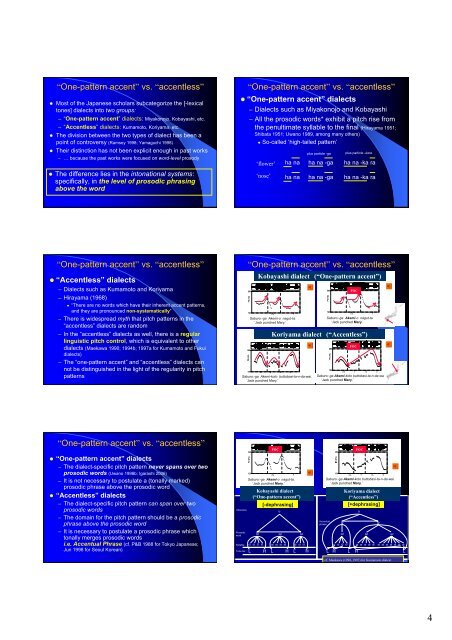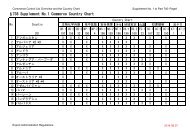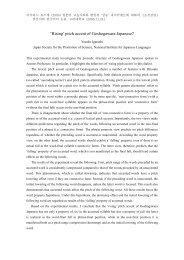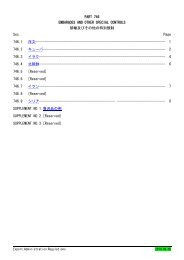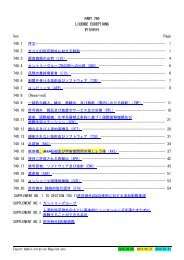Typology of Prosodic Phrasing in Japanese Dialects ... - So-net
Typology of Prosodic Phrasing in Japanese Dialects ... - So-net
Typology of Prosodic Phrasing in Japanese Dialects ... - So-net
Create successful ePaper yourself
Turn your PDF publications into a flip-book with our unique Google optimized e-Paper software.
“One-pattern accent” vs. “accentless”<br />
• Most <strong>of</strong> the <strong>Japanese</strong> scholars subcategorize the [-lexical<br />
tones] dialects <strong>in</strong>to two groups:<br />
– “One-pattern accent” dialects: Miyakonojo, Kobayashi, etc.<br />
– “Accentless” dialects: Kumamoto, Koriyama, etc.<br />
• The division between the two types <strong>of</strong> dialect has been a<br />
po<strong>in</strong>t <strong>of</strong> controversy (Ramsey 1998; Yamaguchi 1998)<br />
• Their dist<strong>in</strong>ction has not been explicit enough <strong>in</strong> past works<br />
– … because the past works were focused on word-level prosody<br />
• The difference lies <strong>in</strong> the <strong>in</strong>tonational systems:<br />
specifically, <strong>in</strong> the level <strong>of</strong> prosodic phras<strong>in</strong>g<br />
above the word<br />
“One-pattern accent” vs. “accentless”<br />
• “One-pattern accent” dialects<br />
– <strong>Dialects</strong> such as Miyakonojo and Kobayashi<br />
– All the prosodic words* exhibit a pitch rise from<br />
the penultimate syllable to the f<strong>in</strong>al (Hirayama 1951;<br />
Shibata 1951; Uwano 1989, among many others)<br />
• <strong>So</strong>-called ‘high-tailed pattern’<br />
‘flower’<br />
‘nose’<br />
ha na<br />
ha na<br />
plus particle -ga<br />
ha na -ga<br />
ha na -ga<br />
plus particle -kara<br />
ha na -ka ra<br />
ha na -ka ra<br />
“One-pattern accent” vs. “accentless”<br />
• “Accentless” dialects<br />
– <strong>Dialects</strong> such as Kumamoto and Koriyama<br />
– Hirayama (1968)<br />
• “There are no words which have their <strong>in</strong>herent accent patterns,<br />
and they are pronounced non-systematically”<br />
– There is widespread myth that pitch patterns <strong>in</strong> the<br />
“accentless” dialects are random<br />
– In the “accentless” dialects as well, there is a regular<br />
l<strong>in</strong>guistic pitch control, which is equivalent to other<br />
dialects (Maekawa 1990; 1994b; 1997a for Kumamoto and Fukui<br />
dialects)<br />
– The “one-pattern accent” and “accentless” dialects can<br />
not be dist<strong>in</strong>guished <strong>in</strong> the light <strong>of</strong> the regularity <strong>in</strong> pitch<br />
patterns<br />
“One-pattern accent” vs. “accentless”<br />
300<br />
Kobayashi dialect (“One-pattern accent”)<br />
120<br />
0.5 1<br />
Time (sec)<br />
Saburo:-ga Akemi-o nagut-ta.<br />
‘Jack punched Mary.’<br />
260<br />
100<br />
0.5 1 1.5 2<br />
Time (sec)<br />
Saburo:-ga Akemi-koto buttobasi-ta-n-da-wai.<br />
‘Jack punched Mary.’<br />
300<br />
FOC<br />
120<br />
0.5 1<br />
Time (sec)<br />
Saburo:-ga Akemi-o nagut-ta.<br />
‘Jack punched Mary.’<br />
Koriyama dialect (“Accentless”)<br />
260<br />
FOC<br />
100<br />
0.5 1 1.5 2<br />
Time (sec)<br />
Saburo:-ga Akemi-koto buttobasi-ta-n-da-wai<br />
‘Jack punched Mary.’<br />
“One-pattern accent” vs. “accentless”<br />
• “One-pattern accent” dialects<br />
– The dialect-specific pitch pattern never spans over two<br />
prosodic words (Uwano 1998b; Igarashi 2006)<br />
– It is not necessary to postulate a (tonally marked)<br />
prosodic phrase above the prosodic word<br />
• “Accentless” dialects<br />
– The dialect-specific pitch pattern can span over two<br />
prosodic words<br />
– The doma<strong>in</strong> for the pitch pattern should be a prosodic<br />
phrase above the prosodic word<br />
– It is necessary to postulate a prosodic phrase which<br />
tonally merges prosodic words<br />
i.e. Accentual Phrase (cf. P&B 1988 for Tokyo <strong>Japanese</strong>;<br />
Jun 1998 for Seoul Korean)<br />
Utterance<br />
Accentual<br />
phrase<br />
<strong>Prosodic</strong><br />
word<br />
300<br />
FOC<br />
120<br />
0.5 1<br />
Time (sec)<br />
Saburo:-ga Akemi-o nagut-ta.<br />
‘Jack punched Mary.’<br />
Kobayashi dialect<br />
(“One-pattern accent”)<br />
Alternative [-dephras<strong>in</strong>g]<br />
representation<br />
α<br />
υ<br />
α<br />
α<br />
ω ω ω<br />
Syllable<br />
σ σ σ σ σ σ σ σ σ σ σ<br />
Tone tier<br />
L H L H L H<br />
260<br />
FOC<br />
100<br />
0.5 1 1.5 2<br />
Time (sec)<br />
Saburo:-ga Akemi-koto buttobasi-ta-n-da-wai.<br />
‘Jack punched Mary.’<br />
Koriyama dialect<br />
(“Accentless”)<br />
[+dephras<strong>in</strong>g]<br />
υ<br />
υ<br />
“Dephras<strong>in</strong>g”<br />
Accentual<br />
phrase<br />
α<br />
ω<br />
σ σ σ σ<br />
ω<br />
α<br />
ω<br />
σ σ σ σ<br />
σ<br />
σ σ σ σ<br />
σ σ σ<br />
L H L H L<br />
cf. Maekawa (1990, 1997) for Kumamoto dialcet<br />
4


